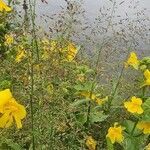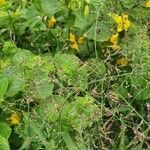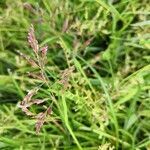Culms 1–7 dm; lvs 3–8(–10) mm wide; infl 8–15 cm, the finely hairy branches divergent, in fascicles of ca 5; first glume ovate, 1–1.7 mm; second glume oblong, truncate and usually erose, 1.6–2 mm; lemmas broadly oblong, 2.2–3 mm, glabrous; anthers 1–1.3 mm; 2n=20. Shallow water or wet soil; circumboreal, s. to N.B., Wis., Nebr., and Ariz.
A grass. It keeps growing from year to year. It grows 10-30 cm tall. It has stolons or runners. The leaves are narrow and 2-8 cm long by 2-5 mm wide.





